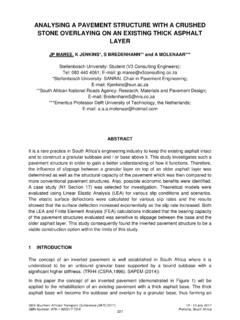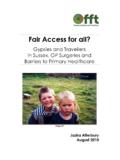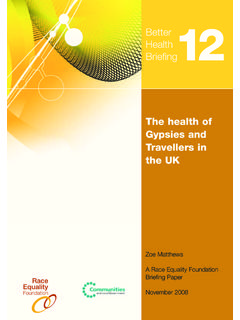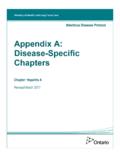Transcription of Southern African Solutions to Public Transport …
1 Southern African Solutions TO Public Transport challenges C MTIZI Department of Logistics, Faculty of Economic and Management Sciences, Stellenbosch University, Private BagX1, Matieland, 7602 Stellenbosch, South Africa, Email: ABSTRACT This essay investigates current challenges faced in the Southern African Public Transport sector and proposes a possible solution to overcome these challenges . Using South Africa and Zimbabwe as case studies, the essay identified shared challenges experienced in both countries for which a universal solution may be adopted. It was found that these challenges could mostly be attributed to government actions. The essay concludes that there is a need for better integration of social outcomes within Public Transport policy at the strategic tactical and operational levels in Southern Africa.
2 Furthermore, it suggests that technology-driven Solutions can be introduced in the Public Transport realm, amongst other Solutions , that entails a universal cashless payment system coupled with GPS technology. 1. INTRODUCTION Urbanisation over the past 20 years, has been one of the main contributors to the economic growth in Southern Africa. This trend is likely to continue and coupled with rapid population growth, it is projected that over 50% people of the world s population will be living in urban areas (The World Bank., 2000). As a result, the growth of informal settlements in the outskirts of metropolitan areas where land is cheaper means that commuters go through long travel times and experience huge travel costs. Public Transport is the primary choice of travel in Southern Africa and is a driver of economic growth.
3 It, therefore, needs to be reliable, affordable, accessible, flexible and safe. This essay identifies challenges in two Southern African countries- South Africa and Zimbabwe highlighting problems that transcend economic structures, geographic location, and traffic together with population movement. Solutions are presented for the identified challenges , however, most of them need active government implementation and constant monitoring and evaluation. 36th Southern African Transport Conference (SATC 2017)ISBN Number: 978-1-920017-73-610 - 13 July 2017 Pretoria, South Africa8182. Public Transport challenges IN SOUTH AFRICA To understand the state of Public Transport in South Africa, the National Household Travel Survey (NHTS) is a clear point to start. Conducted in 2014, it assesses the extent to which Public Transport services are offered and facilities provided and expresses the accompanying cost and affordability for the traveller.
4 The survey reveals that only 30% of households in South Africa own a car with the other 70% depending on taxis, buses, trains and other non-motorised Transport modes. Each of the available modes of Public Transport has various challenges . According to the NHTS, in 2014, train users (42%) were generally more than satisfied (37%) with train services. Travellers place importance on punctuality of service, levels of crowding, distance from the station and the security of trains (NHTS, 2016). However, Metrorail trains have been marred by the constant lack of structure in terms of schedules. They do provide a timetable on their website, but the trains do not show up, of train users claimed it was not available. There is an abundance of the low capacity vehicles (16 seats), which provide a door-to-door service and flexibility to many travellers.
5 There are more accessible than trains, due to the route and network flexibility (NHTS, 2016). Several taxis operate without licenses, in some cases, they are driven by unlicensed drivers. This has been followed by complaints from travellers, who are affected by the violence associated with this Transport mode. Taxi fares alternate due to peak time and weather, and the driving behaviour of most taxi drivers is usually reckless. Problems with the bus service are largely attributed to infrequent bus service during off-peak hours. Bus services do not cover certain routes leaving travellers with the option to walk or use another form of Transport to get to their destination. Buses are a safer option, compared to the other Transport modes. For the average commuter, these challenges translate to longer travel time which has a significant impact on their Transport costs.
6 In addition, the availability of travel information for all the modes of Transport continues to be a challenge. There is a need for greater regulation in this industry because most issues raised by travellers highlighted the absence of policy and universal guidelines that facilitate information sharing among the different players in the Public Transport sector. 3. Public Transport challenges IN ZIMBABWE The economic conditions in Zimbabwe have proven to be the principal challenge to the Public Transport system. After deregulation of the Transport industry, the state-owned bus service provider fleet depleted by 45%, and routes decreased from 450 to 270 (Mbara, 2006). The only buses operational in the country are for long distances between cities and towns and not within.
7 The metro train services have since stopped operating. This has seen a rapid growth in minibus taxis as the primary mode of transportation 819 Without regulation, the taxis have a monopoly of the Public Transport sector. There is an inequitable allocation of routes, resulting in an overproduction of Transport services in one area, excluding other routes. The fares are not set and fluctuate according to economic conditions, weather and feelings of the driver. Overcrowding in the minibus taxis is another problem. Because operators need to make as much profit as possible they overload their vehicles, which results in faster degradation of road infrastructure and accidents. The absence of government intervention in providing a policy to guide and regulate Public Transport provision means they have less influence in the management and planning of the Public Transport sector.
8 This unfortunate situation comes from a lack of capacity in terms of personal resources as well as institutional arrangements at the various levels of authority, in addressing problems facing urban or commuter Transport users. Another challenge in the Public Transport of the country is the payment system. The cash crisis and cash flow problems are leaving people with more electronic money rather than physical. This crisis demands a different ticketing system rather than paying for the taxi. 4. COMMON Public Transport challenges IN Southern AFRICA South Africa and Zimbabwe have different Public Transport structures resulting in different challenges experienced by travellers in each country. Notwithstanding the differences, the countries in Southern Africa do experience the similar problems. With the use of the two diverse countries, the following challenges are common: Infrastructure A good Transport system depends on a reliable Transport infrastructure.
9 Transport infrastructure requires large investments and requires regular maintenance to prevent it from being unsuitable for motorists to use. The high cost of paved road construction tends to limit most major road interventions to the Public sector (Porter, 2007). In Southern Africa, especially in Zimbabwe, the road infrastructure has deteriorated at an alarming rate, with the roads becoming narrower and pot holes damaging vehicles and increasing the maintenance cost to road users. There is a disparity between rural and urban Transport infrastructure. Road infrastructure in rural areas is not as sophisticated as in urban areas, creating a Public Transport challenge in those areas. Another challenge infrastructure presents is its availability. For Transport modes such as trains, the tracks are already in place and the challenge is managing the trains that running on tracks daily, and minor maintenance of tracks.
10 Access in rural areas Workers in the primary sector (mining and agriculture) are in remote rural areas as are seasonal workers of certain crops. Rural areas are often overlooked in Transport planning which presents a great challenge for passengers in those areas. On the other hand, rural 820areas present a spatial problem of people being sparsely situated and the infrequency of their travels. This makes it difficult for a solution to be introduced that satisfies Transport providers, government, and passengers. Overlooking rural areas in Transport planning is a serious challenge that many Southern African countries face. The scholar Transport issue in rural areas is another challenge within the region. Certain Transport operators can be subsidised by the government to Transport scholars to and from school because it is usually a single provider, there is no accountability, responsibility or follow up from the government.






![[Type text] Meningococcal vaccines](/cache/preview/5/c/0/9/3/c/4/7/thumb-5c093c475c779aa4221fa7872a8ed169.jpg)